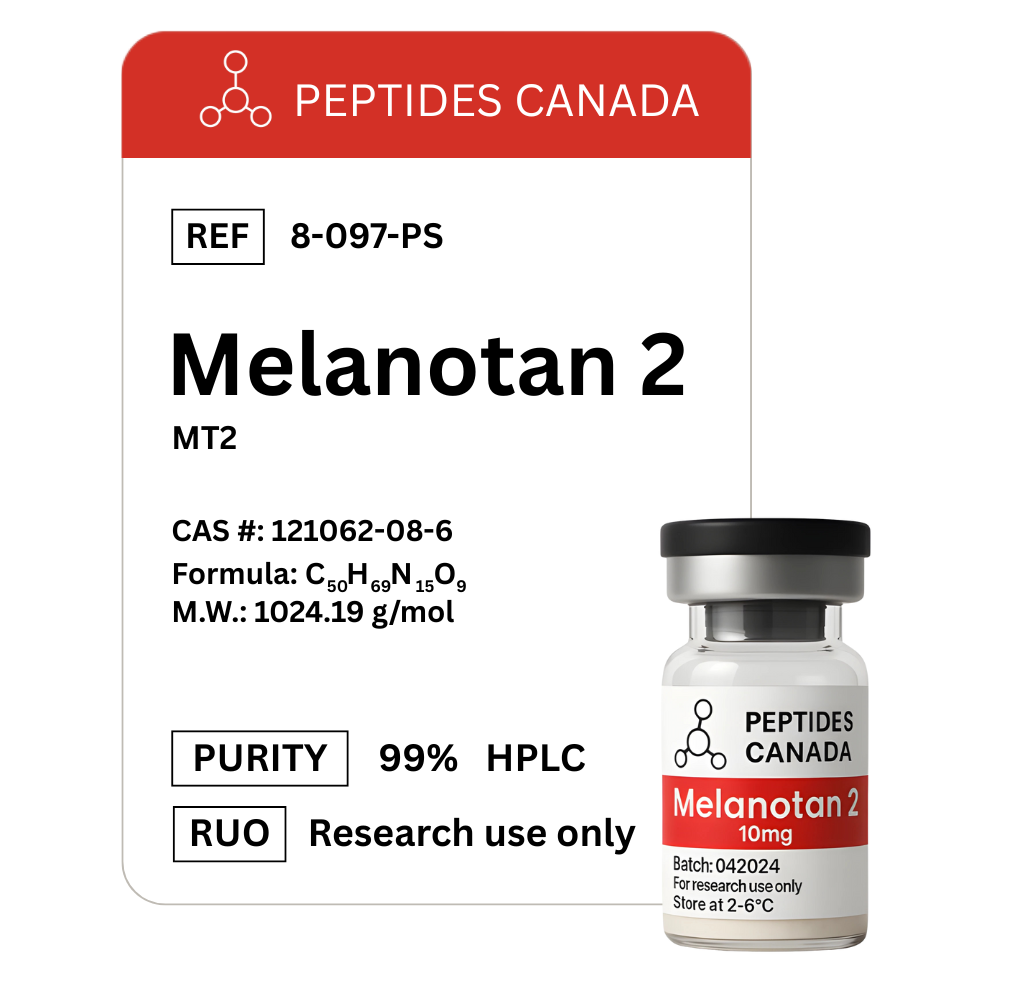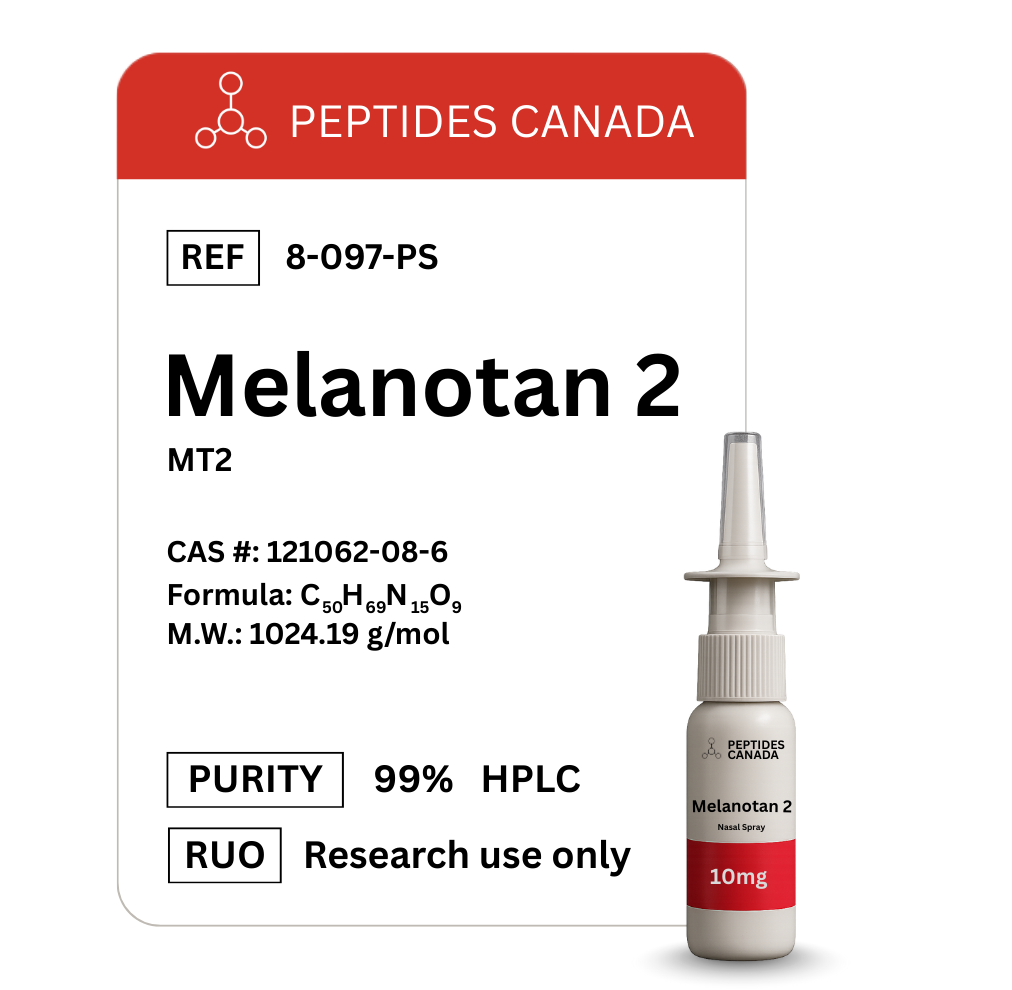Melanotan II (MT2)
From CAD $28 CAD $50
Contents: Melanotan 2
Form: Powder
Purity: 99.5%
TESTED FOR:
- PURITY
- STERILITY
- WEIGHT
- ENDOTOXINS(LPS)
Free Reconstitution solution automatically added to your cart with each order of vial.
This product is Made, Tested & Shipped From Canada.
Ships Today
Order by 1:00 PM EST
Free Shipping
For 2 or more vials
99%+ Purity Guaranteed
COA Verified+
Trackable Shipping
Melanotan 2 Peptide
Melanotan 2 (MT-II) is a synthetic analog of α-melanocyte-stimulating hormone. The peptide is a cyclic heptapeptide that appears to have a modified affinity for several of the same receptors as the endogenous hormone. In addition to potentially stimulating melanogenesis (melanin production) in skin cells, MT-II may also show affinity for receptors involved in appetite regulation and certain arousal pathways.
Overview
Melanotan 2 is often described as a non-selective agonist with the potential to bind four of the five melanocortin receptor subtypes (MC-R). Depending on localization, the MT-II–receptor interaction may lead to different actions. The four receptors MT-II may engage include:
MC1R — expressed on melanocytes in dermal tissues, hair, and some ocular cells.
MC3R — found across multiple tissues, including brain and placenta; preliminarily linked to appetite modulation under certain conditions.
MC4R — localized in the central nervous system, including the hypothalamus; early reports connect it to neurons influencing mating behaviors and general arousal.
MC5R — distributed across several peripheral tissues; its precise role remains less clear.
For example, the interaction between Melanotan 2 and MC1R may increase eumelanin production, resulting in darker epidermal pigmentation.
On the other hand, when Melanotan 2 binds MC4R, it may engage supraspinal centers in the brain, which may lead to increased libido. These signals may then be carried to sympathetic and parasympathetic centers in the spinal cord and thoracolumbar region.
Chemical Makeup
Other Known Titles: MT-II
Molecular Weight: 1024.19 g/mol
Molecular Formula: C₅₀H₆₉N₁₅O₉
Research and Clinical Studies
Melanotan 2 Peptide and Nerve Cell Regeneration
Research in a murine model of induced peripheral nerve injury has been used to explore the neurotrophic potential of Melanotan 2. Within about 48 hours of peptide presentation, treated subjects showed signs of sensory recovery. When a chemotherapeutic agent was introduced, Melanotan 2 also appeared to provide partial neuroprotection against drug-induced neurotoxicity. These effects are proposed to involve MC4 receptors and may support neurite outgrowth and the intrinsic capacity of neural tissue to recover after injury.
Although the exact signaling pathways are not fully defined, POMC-derived melanocortin peptides (including α-MSH analogs) are often discussed for their ability to increase neurite number and length and to encourage sprouting in damaged regions. As a potent melanocortin receptor agonist, Melanotan 2 may trigger intracellular events that help nerve fibers regenerate after various insults and offer some protection in toxic neuropathic conditions.
Melanotan 2 Peptide and Arousal Neurosignaling
A clinical study reported increased arousal-related neuronal signaling in more than 80% of cases with Melanotan 2, compared with about 20% on placebo. The peptide is thought to act through MC4 receptors and downstream of established neuromodulators such as dopamine and oxytocin, integrating signals within hypothalamic centers that coordinate homeostatic and motivational behaviors. Some authors also suggest possible involvement of MC5 receptors in certain peripheral glands, which could provide a parallel link between central signaling and peripheral modulatory factors; mechanisms remain hypothetical.
Melanotan 2 Peptide and Neurodevelopmental Modulation
Melanotan 2 has been proposed to influence atypical neural mechanisms by stimulating neuron populations that govern aspects of social cognition via endogenous oxytocinergic signaling. MC4R-sensitive circuits—described in regions such as the paraventricular nucleus—may release oxytocin in response to Melanotan 2, potentially recalibrating imbalances in neurochemistry that involve serotonin, glutamate, dopamine, and GABA. By engaging these pathways, Melanotan 2 may alter functional connectivity across cortical and subcortical networks (for example, the anterior cingulate cortex), helping to adjust synaptic communication and plasticity.
Melanotan 2 Peptide and Models of Sunless Tanning
Melanotan 2 may boost melanin production and deepen pigmentation without ultraviolet exposure by activating MC1R on melanocytes. Its cyclic design is also described as providing longer-lasting receptor activity than some other MSH analogs.
Although the precise intracellular pathways are not fully mapped, current data indicate that these receptor interactions can elevate eumelanin synthesis. This offers a potential route for developing sunless tanning models under controlled research conditions. Reports from experimental work note increased (darkened) pigmentation on the face, upper body, and buttock.
Melanotan 2 peptide is available for research and laboratory purposes only. Please review and adhere to our Terms and Conditions before ordering.
References:
- Ryakhovsky, Vladimir V et al. “The first preparative solution phase synthesis of Melanotan II.” Beilstein Journal of Organic Chemistry vol. 4 (2008): 39. doi:10.3762/bjoc.4.39. https://pubmed.ncbi.nlm.nih.gov/19043625/
- Mac E. Hadley, Discovery that a melanocortin regulates sexual functions in male and female humans, Peptides, Volume 26, Issue 10, 2005, Pages 1687-1689, ISSN 0196-9781, https://doi.org/10.1016/j.peptides.2005.01.023
- King, Stephen H et al. “Melanocortin receptors, melanotropic peptides and penile erection.” Current topics in medicinal chemistry vol. 7,11 (2007): 1098-1106. https://www.ncbi.nlm.nih.gov/pmc/articles/PMC2694735/
- Peters, Björn, et al. “Melanotan II: a possible cause of renal infarction: review of the literature and case report.” CEN case reports vol. 9,2 (2020): 159-161. doi:10.1007/s13730-020-00447-z. https://www.ncbi.nlm.nih.gov/pmc/articles/PMC7148395/
- Ter Laak, Mariël P, et al. “The potent melanocortin receptor agonist melanotan-II promotes peripheral nerve regeneration and has neuroprotective properties in the rat.” European Journal of Pharmacology vol. 462,1-3 (2003): 179-83. doi:10.1016/s0014-2999(02)02945-x. https://pubmed.ncbi.nlm.nih.gov/12591111/
- Wessells, H et al. “Melanocortin receptor agonists, penile erection, and sexual motivation: human studies with Melanotan II.” International journal of impotence research vol. 12 Suppl 4 (2000): S74-9. doi:10.1038/sj.ijir.3900582. https://pubmed.ncbi.nlm.nih.gov/11035391/
- Minakova E, Lang J, Medel-Matus JS, Gould GG, Reynolds A, Shin D, Mazarati A, Sankar R. Melanotan-II reverses autistic features in a maternal immune activation mouse model of autism. PLoS One. 2019 Jan 10;14(1):e0210389. Doi: 10.1371/journal.pone.0210389. PMID: 30629642; PMCID: PMC6328175.
- Dorr RT, Lines R, Levine N, Brooks C, Xiang L, Hruby VJ, Hadley ME. Evaluation of melanotan-II, a superpotent cyclic melanotropic peptide in a pilot phase-I clinical study. Life Sci. 1996;58(20):1777-84. doi: 10.1016/0024-3205(96)00160-9. PMID: 8637402.
Dr. Marinov
Dr. Marinov (MD, Ph.D.) is a researcher and chief assistant professor in Preventative Medicine & Public Health. Prior to his professorship, Dr. Marinov practiced preventative, evidence-based medicine with an emphasis on Nutrition and Dietetics. He is widely published in international peer-reviewed scientific journals and specializes in peptide therapy research.
HIGHEST QUALITY PEPTIDES
Our products are scientifically formulated and manufactured in cGMP-compliant facilities.
FAST DELIVERY
Enjoy fast and reliable 3–5 day shipping.
Dedicated Customer Service
Our customer service team is highly knowledgeable in peptide research and its applications. We’re available 24/7 to assist you.
Tested. Verified. Trusted.
We take a laboratory-first approach to quality. Each batch is made under controlled conditions and verified by an independent lab (HPLC/MS). We only ship batches that test ≥99% purity, and we provide a full COA, including identity, methods, and chromatograms, for your review.
See the Process for Yourself
We make our peptides in our own cGMP lab. Watch the video to see how every vial is produced, tested, and handled with care.
Science Behind Our Peptides
A clear explanation of how our peptides work, their benefits, why quality matters for best results, and what you should know.
Categories
Categories
How do I know the peptides I order are exactly what the label says?
Every vial we sell comes from a lab that follows current Good Manufacturing Practices (cGMP). That means each step of production is documented and controlled. Before a batch is released, it’s tested by independent third-party labs for purity, identity, and sterility. Certificates of analysis are available so you can see the exact test results.
Are your peptides produced in a sterile and controlled environment?
Yes. The labs we work with use ISO-certified clean rooms where air quality, equipment, and handling procedures are tightly regulated. Staff are trained to pharmaceutical-grade standards. This ensures the peptides are produced in an environment that minimizes contamination risks.
What about shipping? Do the peptides remain stable in transit?
Peptides in lyophilized (freeze-dried) form are stable at room temperature for transport. Once you receive them, refrigeration is recommended to maintain long-term integrity. We package every order securely to prevent damage and ship promptly, so your vials arrive in optimal condition.
How do I know you actually make these peptides yourselves?
We operate under strict in-house protocols that follow current Good Manufacturing Practices (cGMP). That means our team oversees the entire process from sourcing raw amino acids to the final lyophilized vial. Nothing is outsourced or repackaged. This gives us full control over purity, consistency, and sterility, and it’s why we can stand behind every single vial we ship.
What should I do with the vials once they arrive?
Store them in the refrigerator, away from direct light and heat. If you need to keep them longer, some peptides can be stored frozen. Each vial comes with clear handling instructions so you know the proper conditions for stability.
What proof do you have that your peptides are legitimate?
The strongest proof is transparency. For every peptide, we can provide certificates of analysis, manufacturing documentation, and references to the published scientific research behind it. If you ever have questions, we’ll show you the data rather than ask you to take our word for it.




